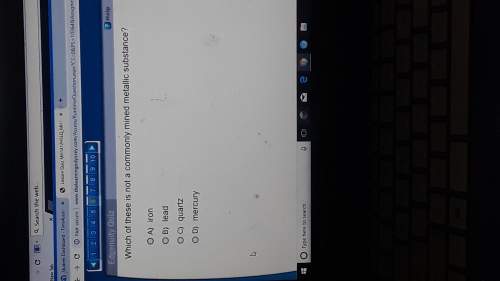
Enter the electron configuration for I+ using noble gas shorthand notation.
In the first box enter the noble gas (notice the brackets). In the following boxes enter the number that goes in front of the orbital followed by the superscript.
For example, the electron configuration for sulfur is: [Ne]3s2 3p4
so the first box would have Ne in it followed by 3, then 2, then 3 then 4.
If you do not need an orbital, just enter 0 (zero) in the boxes for the coefficient and superscript.
[ ] s f d p
Find the element in the periodic table and count over
to the right the number of negative charges on your anion.
This element has the same electron configuration as your anion.
Which noble gas precedes the element? Knowing the s, p, d, and f blocks
of elements in the periodic table, deduce the the electron configuration
of the element from the preceding noble gas. Remember that the
1p 1d, 2d, 1f, 2f, and 3f orbitals are forbidden energy levels (they do not exist).

Answers: 2
Other questions on the subject: Chemistry

Chemistry, 22.06.2019 20:00, jalenevoyles
Phosphoric acid is a triprotic acid ( =6.9×10−3 , =6.2×10−8 , and =4.8×10−13 ). to find the ph of a buffer composed of h2po−4(aq) and hpo2−4(aq) , which p value should be used in the henderson–hasselbalch equation? p k a1 = 2.16 p k a2 = 7.21 p k a3 = 12.32 calculate the ph of a buffer solution obtained by dissolving 18.0 18.0 g of kh2po4(s) kh 2 po 4 ( s ) and 33.0 33.0 g of na2hpo4(s) na 2 hpo 4 ( s ) in water and then diluting to 1.00 l.
Answers: 3


Chemistry, 23.06.2019 02:30, hailee232
When the ionic compound nabr dissolves in water, br– ions are pulled into solution by the attraction between what two particles? a. the na+ and br– ions b. the na+ ion and the negative end of a water molecule c. the br– ion and the positive end of a water molecule d. the br– ion and the negative end of a water molecule
Answers: 1

Chemistry, 23.06.2019 06:30, kaitlynk0
Which of the following is true about the products formed during photosynthesis? (5 points) select one: a. they have the same mass as the mass of reactants. b. they are the same set of compounds as the reactants. c. they have more mass than the mass of reactants. d. they are chemically the same as the reactants.
Answers: 1
Do you know the correct answer?
Enter the electron configuration for I+ using noble gas shorthand notation.
In the first box enter...
Questions in other subjects:

Mathematics, 29.07.2020 23:01

Chemistry, 29.07.2020 23:01

Mathematics, 29.07.2020 23:01




Mathematics, 29.07.2020 23:01


Mathematics, 29.07.2020 23:01







